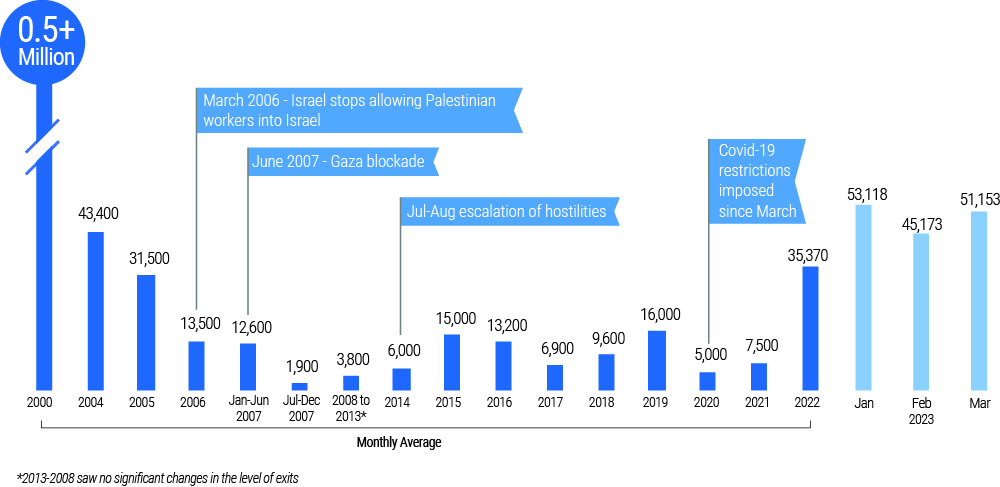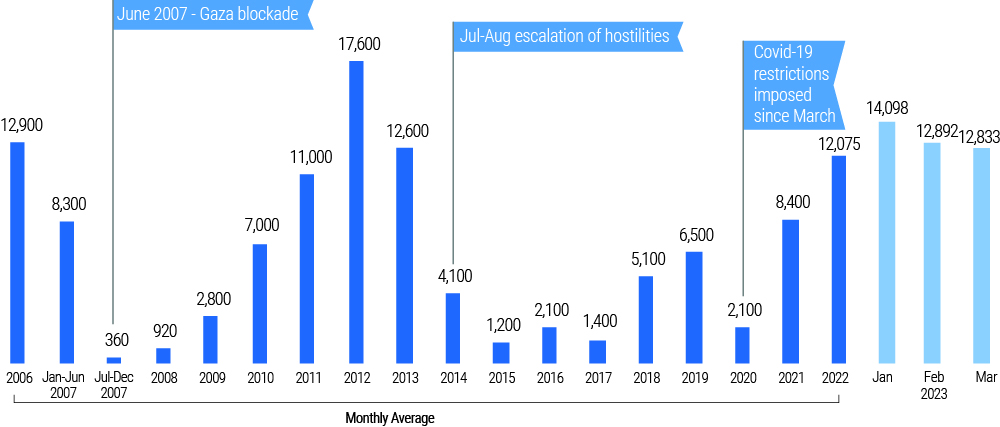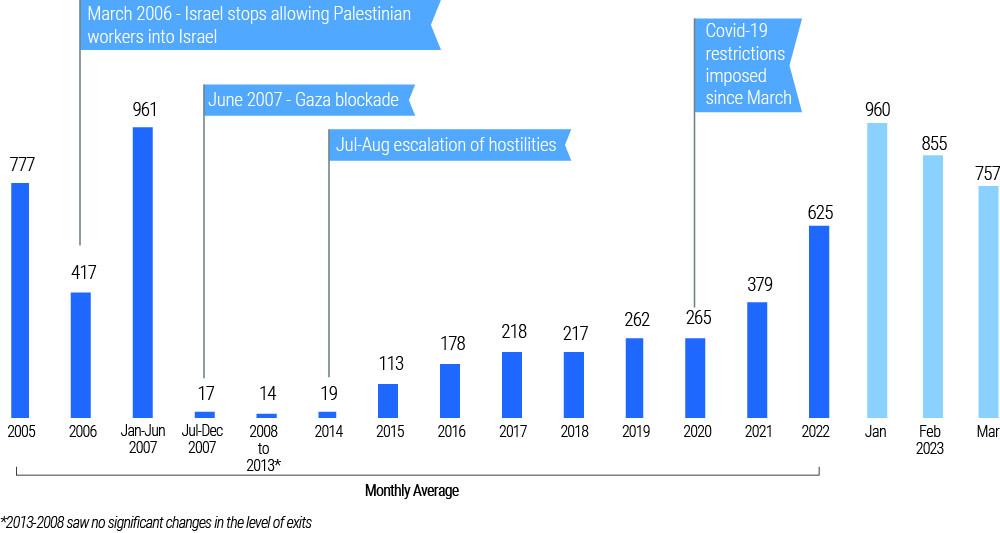Movement in and out of Gaza: update covering March 2023
Highlights
- In March 2023, more people crossed in and out of Gaza, with the Israeli authorities increasing the number of exit permits for work purposes.
- However, movement remained highly restricted, with most people still not eligible to apply for permits.
- More goods entered Gaza, while fewer goods exited.
Background: Longstanding restrictions on the movement of people and goods to and from Gaza have undermined the living conditions of its over two million Palestinian residents. Many of the current restrictions, originally imposed by the Israeli authorities in the early 1990s, were intensified after June 2007, following the Hamas takeover of Gaza, when the Israeli authorities imposed a blockade. Despite some easing of import restrictions since 2021, the remaining limitations continue to hinder access to livelihoods, essential services, and housing, disrupting family life and undermining people’s hopes for a secure and prosperous future. The situation has been compounded by the restrictions imposed by the Egyptian authorities at Rafah crossing.
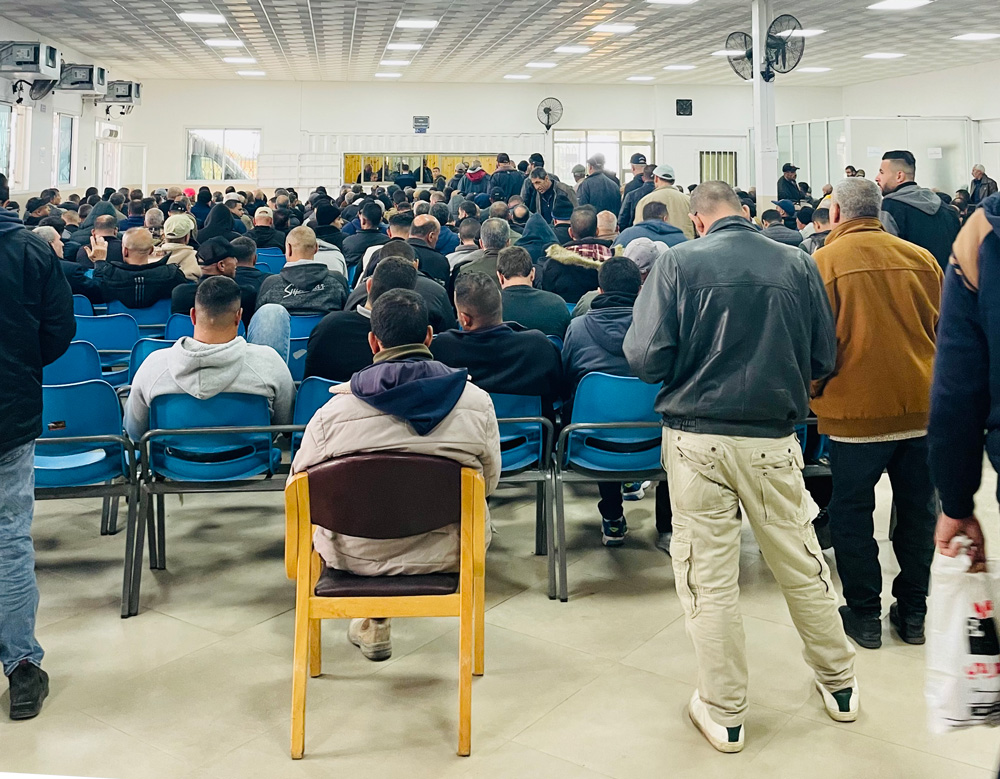
Palestinian day labourers waiting to exit Gaza through the Israeli-controlled Erez crossing in the northern Gaza Strip, 26 March
Movement of people to Israel and the West Bank
- In March, the Israeli authorities allowed 51,153 exits of people from Gaza (in most cases, travelers exited multiple times). This is 13 per cent higher than in February, and 44 per cent higher than the monthly average in 2022. However, it is 90 per cent lower than the monthly average in 2000, before the imposition of category-based restrictions by the Israeli authorities.
- Up to 88 per cent of the exits were by Palestinians allowed out for work-related purposes, most of whom are employed as day labourers in Israel. The Israeli authorities increased the number exit permits for such purposes from 20,787 in February to 21,306 in March.
- Six per cent of the exits were by patients referred for medical treatment in the West Bank or Israel and their companions. Some 1,641 exit-permit applications were submitted to the Israeli authorities for medical appointments scheduled for March. Of these, 18 per cent were not approved on time, compared with 15 per cent in February. Click here for more information.
Background: Palestinians are banned from exiting Gaza via Israel, including for passage to the West Bank, unless they obtain an Israeli-issued exit permit. Only those belonging to certain categories, primarily day labourers, traders, patients and their accompaniers, and aid workers, may apply for such permits. Other people are not eligible for a permit even if according to the Israeli authorities they do not pose a security risk. In many cases, the Israeli authorities do not provide specific reasons for the rejection of an application. If an application is approved, the permit holder may travel through the Israeli-controlled Erez crossing, which operates during the daytime, from Sunday to Thursday, and on Fridays for urgent cases and foreign nationals only.
Movement of people to Egypt
- In March, the Egyptian authorities allowed 12,833 exits (some travelers may have exited multiple times). This is similar to the number of exits allowed in February 2023, and 6 per cent more than the monthly average in 2022.
- Some 132 people were denied entry to Egypt, down from 360 denials in February 2023. The grounds for denial are typically not provided, but according to the local Palestinian authorities, Egyptian counterparts have often cited security concerns or specific age limits that often apply to men aged 18-40.
Background: Palestinians wishing to exit Gaza via Egypt must register with the local Palestinian authorities two to four weeks in advance. People may also apply to the Egyptian authorities, using the services of a private company. The procedures and decisions by both authorities lack transparency. Approved passengers exit through the Rafah Crossing, which is controlled and operated by the Egyptian authorities from Sundays to Thursdays. The journey through the Sinai desert is often lengthy and includes multiple stops for checks by Egyptian security forces.
Incoming goods
General goods (excluding fuel and gas)
- In March, 10,213 truckloads entered through the Israeli and Egyptian borders. This is 11 per cent higher than in February 2023 and 15 per cent higher than the monthly average in 2022. However, this is still 9 per cent lower than the monthly average on the eve of the blockade in 2007, although Gaza’s population has grown by more than 55 per cent since then.
- Of the goods that entered, 39 per cent were construction materials and 25 per cent were food supplies. About 3 per cent was humanitarian aid facilitated by international organizations, mostly food and medical supplies.
- Some 69 per cent of the goods entering, went in via Israel. This volume is 20 per cent higher than in February 2023, and almost 14 per cent higher than the monthly average in 2022. Over 28 per cent of it was construction materials (mainly aggregates, cement, and steel bars). This is 4 per cent higher than the monthly average in 2022.
- The remaining 31 per cent of the goods entering, went in via the Egyptian border, which opened for imports on 13 days. This is 6 per cent below the volume in February 2023 but still about 17 per cent higher than the monthly average in 2022.
- Of the goods entering via Egypt, more than 71 per cent were construction materials. Most of the remaining goods were food items.
Background: Since the imposition of the blockade in 2007, the Israeli authorities have restricted the entry into Gaza of goods they consider having a dual (civilian and military) use, such as building materials, certain medical equipment, and some agricultural items. Some of these goods may be allowed entry, following a lengthy application and review process. The entry of most of goods from or via Israel (including non-restricted goods) is only possible via the Kerem Shalom crossing, following prior coordination with the Israeli authorities. Since 2018, goods have also entered Gaza regularly from Egypt, via the Rafah crossing, controlled by the Egyptian authorities, and then through the adjacent Salah Ad Din Gate, controlled by the local authorities.
Monthly average of incoming goods to Gaza (truckloads)
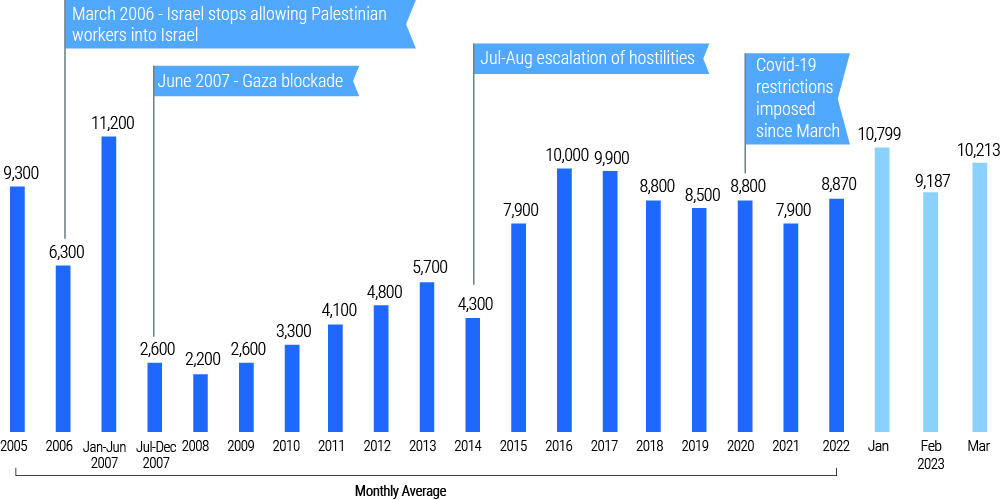
Fuel and gas
- The volume of petrol and diesel entering Gaza from Israel and Egypt in March decreased by 4 per cent compared with February. It was also 10 per cent lower than the monthly average in 2022. No restrictions are imposed on the import of fuel of any type, but funding and storage capacity are limited.
- Cooking gas imports decreased by 6 per cent compared with February 2023. The volume was slightly higher than the monthly average in 2022.
- The volume of industrial diesel entering for the Gaza Power Plant increased by 7 per cent compared with February 2023. It was 10 per cent higher than the monthly average in 2022.
Outgoing goods
- In March, 757 truckloads exited Gaza through the Israeli and Egyptian borders. This was 12 per cent lower than in February 2023, but still 21 per cent higher than the monthly average in 2022. The decline is attributable to the end of the export season of some of the authorized agricultural items.
- Some 589 truckloads of authorized goods exited through the Israeli border. This was 19 per cent below the volume of exits in February 2023, and 39 per cent below the monthly average on the eve of the blockade in 2007.
- About 65 per cent of these goods went to the West Bank, 35 per cent were exported to Israel, and less than 1 per cent were shipped abroad. Vegetables accounted for 64 per cent of the exiting goods, strawberries for 13 per cent, textile for 9 per cent, scrap iron for 5 per cent, and the remainder 9 per cent included furniture, scrap aluminium, and fish.
- Another 168 truckloads were exported to Egypt, carrying scrap iron and aluminium as well as used batteries. This is 18 per cent higher than in February. In 2022, the Egyptian authorities allowed only used batteries, scrap iron, aluminium, and copper to exit.
Background: Most products traded outside of Gaza are transported to markets via the Israeli-controlled Kerem Shalom crossing, where various restrictions apply. The exit of goods to the West Bank and Israel, Gaza’s main markets, was banned between 2007 and 2014, and then gradually reinstated. Since August 2021, certain goods have been exported to Egypt, via the Salah Ad Din gate and Rafah crossing.
Data source: Ministry of National Economy in Gaza. More data: ochaopt.org/data/crossings
